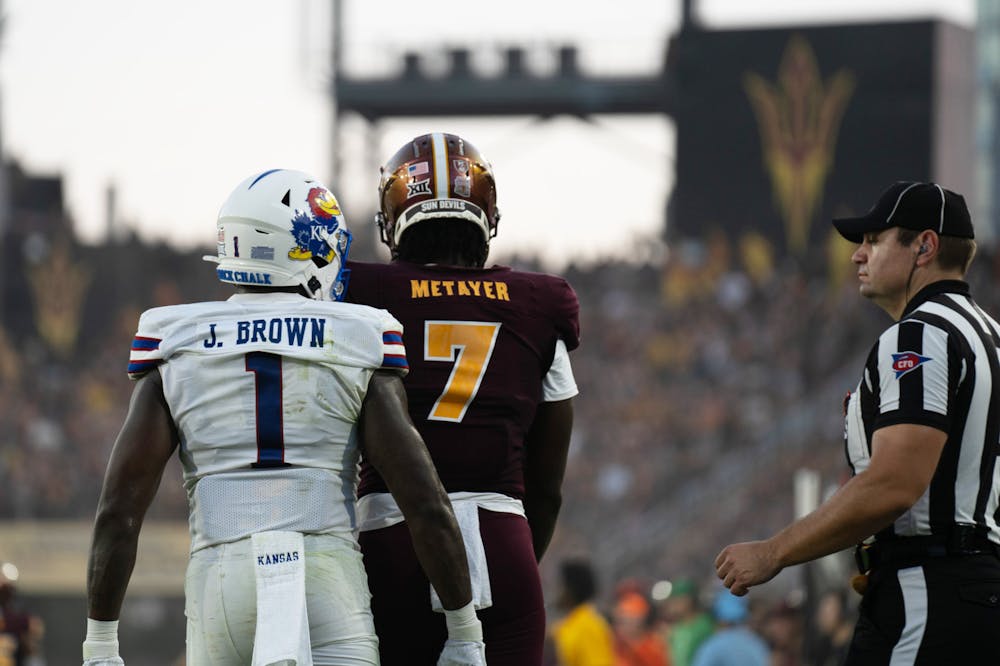Five games into the 2024 season, ASU's offense has performed commendably. Led by redshirt freshman quarterback Sam Leavitt and a strong rushing offense, the Sun Devils have scored 166 points in five games.
It took 10 games for ASU to reach the same mark last year.
However, one aspect of ASU's offense appears underwhelming at first glance — the production of its receivers. Through five games, ASU's wide receivers and tight ends have combined for 701 yards and 56 receptions. Those marks respectively rank last and second to last in the Big 12 Conference.
It would be easy to state the receivers have underperformed. Low numbers, unsurprisingly, do tend to indicate low performance. But with ASU's receiving core this season, the numbers don't paint the whole picture.
For one, the Sun Devils' offense is centered around senior running back Cam Skattebo. He takes up a large portion of the team's touches, which results in fewer opportunities for receivers in the passing game.
Skattebo's contribution as the offensive focal point is a large reason why ASU has run the ball 223 times this season, the 25th most in the nation. The Sun Devil's passing game, on the other hand, ranks 28th least in the nation in total receptions.
Additionally, because of the heavy running attack, a unique point of emphasis for ASU's receivers is blocking. Because the Sun Devils have run on 62% of their plays this season, ASU's receivers have had to block a lot more than other receivers around the country. Thus, it might be best to assess the group based not only on its receiving but its blocking as well.
"Especially with a running back like Skatt, our job is just to get in the way and make sure our guy doesn't make the tackle," wide receivers coach Hines Ward said. "Usually when you see explosive plays in the run game, you see wide receivers blocking their tails off down the field."
Another reason for the limited production at the receiving positions might be limited depth. According to head coach Kenny Dillingham, ASU's offense has six main wide receivers. Those players are redshirt sophomore Jordyn Tyson, redshirt senior Xavier Guillory, graduate student Melquan Stovall, redshirt senior Jake Smith, redshirt senior Troy Omeire and redshirt freshman Derek Eusebio.
Beyond Tyson and Guillory, ASU's other four depth-pieces at wide receiver have combined for only 122 yards on 11 receptions. Behind redshirt junior tight end Chamon Metayer, ASU's backup tight ends have combined for 20 yards on 2 receptions.
According to Dillingham, it would be ideal for ASU to have 7-8 wide receiving options on offense. With the announcement of senior wide receiver Malik McClain's redshirt, that amount of depth is no longer a possibility.
"Does (McClain's redshirt) hurt us a little bit this year? 100%. He was a really, really good depth guy," Dillingham said. "But for him personally and for us in the future, it's win-win for him and for us to get him back (next year)."
However, one thing not missing from ASU's receiving group this year is standouts. The two receivers that have stepped up the most have been Tyson and Metayer. With the loss of ASU's two top receivers in 2023, Elijah Badger and Jalin Conyers, it appeared ASU's receivers may be one of the lone groups that take a step back in 2024.
Even though ASU's receiving core hasn't statistically lined up with the rest of the conference, Tyson and Metayer are still on track to have similar seasons to Badger and Conyers in 2023.
In fact, through five games this season, both Tyson and Metayer have put up comparable numbers to Badger and Conyers. Tyson has 20 receptions for 285 yards and three touchdowns so far this season. In the first five games last season, Badger had 21 receptions for 288 yards and two touchdowns.
"My strongest skill set is that I'm so versatile," Tyson said. "The offense can line me up in the slot, they can line me up outside, and they can run me on every single route."
Metayer has 132 yards and two touchdowns on 12 receptions, while Conyers had 179 yards, no touchdowns, and 17 receptions through the same stretch last year.
"He definitely is great with the ball in his hands," Dillingham said regarding Metayer. "One of the things he does that people don't really give him credit for, he's a really, really, really physical blocker, very physical blocker. If you watch him play the game of football, he plays the game extremely violent, extremely physical."
To say Sun Devil receivers have underperformed this season would be a misstatement. ASU's heavy rushing attack necessitates less receiving production and more blocking, which results in fewer numbers. And while increased production from the depth of ASU's receiving core could improve the offense, the Sun Devils' main standouts, Tyson and Metayer, have the capacity and skillset to keep the group afloat.
One thing that certainly can't be said of ASU's receivers is that they're not improving.
"It's just great to see the growth in all of our wideouts from the point before I got here, from day one, to who they are now," Ward said. "It's like night and day. But, we still got a long way to go. We haven't really achieved that much. I want consistency. That's what I'm going to search for. I'm on a constant quest of trying to find consistent playmakers who are great at making the routine plays."
Edited by Henry Smardo, Alysa Horton and Madeline Schmitke.
Reach the reporter at jwkartso@asu.edu and follow @kartsonis3 on X.
Like The State Press on Facebook and follow @statepress on X.
Jack is a sophomore studying sports journalism. This is his second semester with The State Press. He has also worked at other student journalism organizations.




